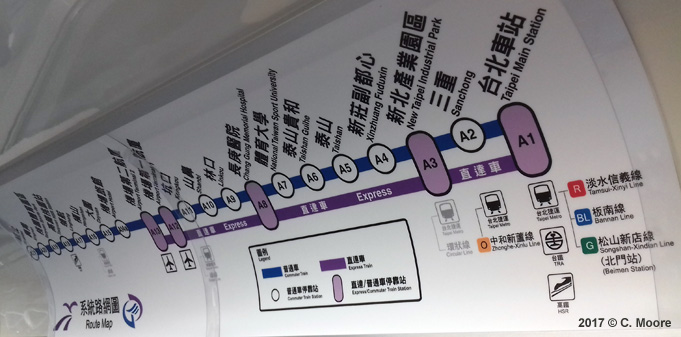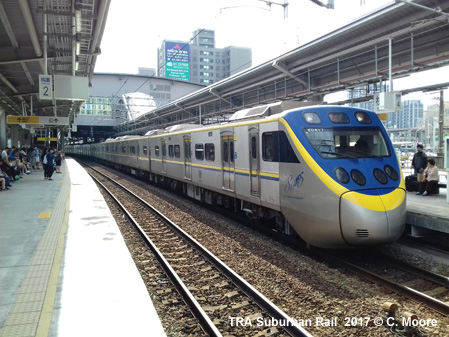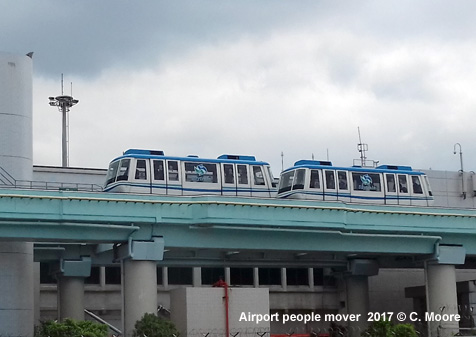|
[ UrbanRail.Net ] [ Europe ] [ Americas ] [ Asia ] [ Africa ] [ Oceania ] [ News ] [ Books ] [ Links ] [ Blog ] [ Shop ] |
|
TAOYUAN
|
| Taiwan |
|
[ UrbanRail.Net ] [ Europe ] [ Americas ] [ Asia ] [ Africa ] [ Oceania ] [ News ] [ Books ] [ Links ] [ Blog ] [ Shop ] |
|
TAOYUAN
|
| Taiwan |
Click on map
to expand to full Taipei/Taoyuan area!
| TAOYUAN METRO | |
|
Located 40 km southwest of Taipei, Taoyuan has grown as a satellite city for the capital and is home to the international airport. It is now the fourth largest metropolitan area in Taiwan with a population of 2.2 million (1221 km2). The Taoyuan Metro Corporation is a joint venture between the municipal governments of Taoyuan, Taipei, and New Taipei City and since the early 2000s it has been planning and developing a five-line urban rail system through Taoyuan. Originally, the Blue Line was designed as a separate service, linking Zhongli and western parts of Taoyuan to the high-speed rail station and airport, but this project was eventually merged with the Airport MRT project which commenced construction in 2006, thus creating a through-running service from Taoyuan to Taipei. The Taoyuan MRT (A Line) began operations in early 2017. Although underground at both terminals and the airport, 80% of the route is on earthquake-proofed viaduct, some sections being built 30-40 m high to manage the hilly terrain. The line has two service types - commuter trains (Blue Line) run from Huanbei to Taipei, the longest metro line in Taiwan, serving all stations with 15 min frequencies (1h20); while Airport Express trains (Purple Line) run from the Airport area to Taipei (39 mins) every 30 mins, calling at only two intermediate stations. There are passing loops along the route to facilitate mixed service types. 4-car Kawasaki trains are used, with the Airport Express units having an additional luggage car to facilitate city centre check-in/baggage drop for passengers of certain airlines. The lines offer transfer to/from the Taipei Metro at Taipei Main Station and NTIP, although separate tickets are required. Taipei Main Station – Laojie River; 52.3 km, 26 stations 02 March
2017: Taipei Main Station – Huanbei (regular service launched) |
|
|
|
|
| Links | |
|
Taoyuan Metro Corporation (official site) Taipei Rapid Transit Corp. Website (official, English version) Taipei Rapid Transit Projects (governmental) Taoyuan Metro at Wikipedia Taipei at UrbanRail.Net
|
|
| Report | |
|
In May 2017, Craig Moore reports from Taoyuan: Taoyuan MRT Being located close to Taipei, Taoyuan has long acted as a western satellite city for the Taiwanese capital. It is, however, a distinct city in its own right. Rapid urban expansion in East Asia has meant that several large cities in the region have similar such satellite cities with separately branded Metros (e.g. Incheon, Foshan), but these are integrated in different ways (operations, ownership, tickets, brand) to the larger neighbouring system. This is not the case here where, despite the line running to central Taipei, the Taoyuan MRT is a separate system with a separate identity and operation from that of the magnificent Taipei MRT. Although at the moment passenger numbers are higher on the airport to Taipei section of the single line, once the 5-line network is completed, the gravitational pull of the Taoyuan MRT will be firmly within the city. _ The Line The Taoyuan MRT is currently a single line which runs from Taipei Main Station to Huanbei in western Taoyuan and is 51.0km with 21 stations (10.1km/6 stations underground). The line runs due west to the International Airport before heading south through the western suburbs of Taoyuan, completely avoiding the centre of the city. It operates standard gauge with third-rail power supply. At Taiwan Main Station (A1), the station entrance is 300 metres from the Taipei MRT station of the same name (separate tickets required). This is the largest station on the system (with airline check-in facilities). It has a large atrium and escalators to the busy ticket hall where, upon entry to the system, there are further escalators to either of the two island platforms. Currently only the two inner lines are used, the southern platform for the Airport Express service and the northern platform for the Commuter service. The ticket hall, like all on the line, has a row of smart ticket machines, a circular customer information centre providing basic hard-copy information and maps, and ticket barriers. Walls have station information, the basic schematic map and locational map. The underground station and platforms have a pale cream colour with little other colour except for advertising on the panels between the full screen doors, lilac station name boards (English and Traditional Chinese) located on walls and pillars and the schematic map. The platforms are quite bare and basic. The line initially runs westward in tunnel under the Tamsui River for 2.1km. On the western bank the line emerges to an elevated structure with noise barrier tubing. As the line heads north there are good views of the dense urban environment of New Taipei City (the river being the boundary of Taipei proper). The first elevated station, Sanchong (A2), lies on this stretch (150m from the Taipei MRT Sanchong Station) before the line moves west. The elevated stations on this stretch have arched corrugated roofs with island platforms. The elevated platforms have half screens, RTI information screens (with very small text, current time and time of next train) and the unstylish schematic map. There is a grey tone to these platforms and they have a quite cluttered feel with centrally located escalators and stairs leading to the ground-level ticket halls. Despite their newness, the elevated stations also look quite worn. NTIP (A3) has double island platforms with Commuter trains using the outer lines and Express services running on the central lines. This has a double-arched roof. The next three stations (A4-A6) are identical and have side platforms and more angular curved roofing. This stretch of the line offers great views of the mountains that surround the greater Taipei area. After Taishan Guihe (A6) the line begins a steep climb through a densely wooded valley for 6mins before entering a 1.9km tunnel at NTSU station (A7) which has separated shallow island platforms. These are very smart with pale green panelling. The line continues a less extreme climb through Chang Gung Memorial Hospital (A8) which has twin island platforms for use of both Express and Commuter services. Here Commuter services have lengthy dwell times to allow for Express services to stop and then pass the slower trains. This is a smart station with twin flat roofs and is quite busy with passengers transferring between service types. The area here is quite densely populated and the line twists and runs quite slowly to Linkou (A9), a broad station with side platforms and 4 tracks, the Express service using the central ‘fast’ lines. At 15.2km from Taipei Main Station, this is the last station in New Taipei City before the line moves into Taoyuan City. The line here again climbs and meanders through deep wooded valleys on very high pillars (earthquake proof) and the surroundings are much less densely populated. The service takes 10mins to reach Shanbi (A10) from where the line runs down to the airport area with side ramps to and from the large stabling facilities at Kengkou (A11) - these two stations are basic with side platforms. From here starts the 5.6km tunnel under the airport, including 3 stations. Airport Terminal 1 (A12) has a shallow island platform and full screens and Airport Terminal 2 (A13) has side platforms. This is the terminus of the Express Line (Airport MRT) and behind screens at the eastern end of the platform there are bays where checked-in luggage from Taipei Main Station is off-loaded. Both stations are busy and the ticket halls are smart with interesting ceilings housing the names of famous world cities. The entrance halls have banks of ticket machines and are supported by armies of friendly staff helping the many new passengers. To note, A12 spits passengers out in the departure hall of Terminal 1, and so arriving passengers wishing to use the MRT are directed to a narrow corridor at the side of the terminal which accesses the departure area. At Terminal 2, the A13 station is in the basement of the terminal (Level B2) and is not well signposted at all from the terminal hall. Both stations have lifts or long declining moving walkways. Airport Hotel Station (A14a) has an island platform and shortly afterward the line has a long ramp to the elevated section which heads south toward the Taoyuan THSR station. With the exception of the underground terminus, all the stations on this part of the line (Stations A15-A20) are identical but different in style from those before the airport, with red walled stairways on the exterior and separate arched roofing on each platform. Linghang (A17) has several switches and ramps as it is the location for the second shedding facility and the HQ of Taoyuan MRT. Taoyuan HSR Station (A18) has high passenger numbers and enables passengers from the south of the country to access the airport more easily and speedily than in the past. It is also home to a large shopping Centre. Taoyuan Sports Park (A19) is also busy, being located next to the Baseball Stadium. The line is quite windy here and trains run very slowly through the low density western suburbs of Taoyuan down to the 0.4km underground section to the current terminus at Huanbei, a basic island platform station with full screens of tinted glass topped by white panels with station names. _ The Service Two types of services operate on the line. The Commuter Line runs for the entire length at 15min headway from 0600-0000. The advertised journey time is 1h 08mins but there is such slow running and long dwells to wait for passing Express trains that the journey takes 1h 17mins. The Express Line runs from Terminal 2 to Taipei Main Station also at 15min frequencies. This service only stops at A3 and A8 between Taipei and the airport and takes 37mins. Even on this line, running is quite slow with 45-50kph the norm, and much slower in parts, especially on the hills. Both services use Kawasaki stock. The Commuter stock has 4 cars and a blue side stripe with ‘Commuter’ broadly labelled in Latin and Chinese letters. This has side lilac bucket seating and a card strip map located in the middle of the carriage. There is also an LCD screen by each door which provides MRT advertising, a platform diagram of the upcoming station and a set of interesting information including current speed, time due at the next station and time due at the terminus - this last figure changes constantly as the train runs behind schedule. The Express stock has a light purple stripe with ‘Express’ labels on the side. These trains have 5 cars with the last carriage being an enclosed carriage for the checked-in luggage. These trains have paired seating and plentiful luggage space, as well as LCD screens with flight information. Above carriage connectors there is an arched electronic line progression showing just the 5 stations served by the Express service. Both trains offer electronic and audio information in Mandarin and English. There is also audio information in Hokkien. Tickets are in the form of a lilac token, although most locals use electronic cards (which offers free use between the two airport terminals). Fares are quite expensive ranging from 30-160NT$ (€0.90-4.75) and there is also a day ticket available for 350NT$ (€10.40). Again, this is expensive given the limited areas the line serves and the infrequency of service. There is no ticket inter-operability with the Taipei MRT. In summary, although there are occasional flashes of design style, the overall appearance is pretty basic and unstylish, looking a little grubby, even at this young age. The line runs very slowly and headways are not very good but service levels are adequate for current demand (this does not appear to be a very well used system) and even on the busiest sections there are always seats available. Having said that, it is great to have a rail link to the airport, and the views from the train and the infrastructure on the elevated section between Sanchong and Linkou are impressive. In addition to the MRT, Taoyuan is also a main southern terminus of the TRA Taipei local suburban rail services (See Taipei page for information). Services operate from here to Taipei and onward to Keelung or Qidu at 8 to 15min frequencies using 10 car Nippon Sharyo stock. These are very busy services and all utilise the 21km underground tunnel (5 stations) in Taipei. Finally, the airport also has a landside people mover between T1 and T2. The 0.7km line runs at 4min frequencies and is located at the extreme southern end of the terminals, with access via long cramped walkways, lifts or narrow stairs. As far as airport people movers go, this is an immediately forgettable specimen. |
|


 |
|
2016 © UrbanRail.Net by Robert Schwandl.